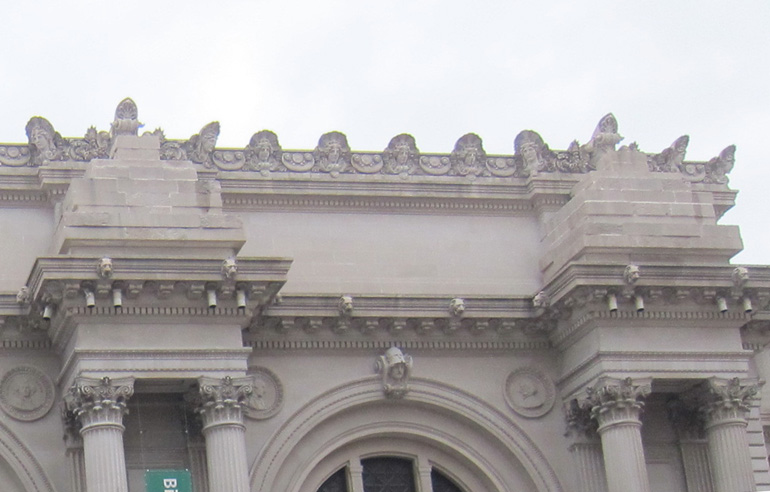Gotham Diary:
Craft and Glamour
22 February 2013
Last night, we attended a members’ preview of the new show, making a stop from the Orsay to the Art Institute, “Impressionism, Fashion, and Modernity.” It’s a ridiculous title; I’d have called it “The Milliner’s Shop,” after the ravishing Degas of that name, a painting that fuses the three concepts in the clunky actual title in a burst of aesthetic genius. (It is in the show.) I didn’t buy the catalogue, because I never do buy catalogues at previews; one wants to think about adding yet another tome to the buckling shelves. And I didn’t want to lug it to dinner afterward. But these were poor reasons; we had dinner at a restaurant that’s on the way home, and there was no doubt in my mind that I would buy the catalogue. And not just look at it but read it. Because, thanks to some sort of quasi-fortuity, I’m primed to read about fashions of the late Nineteenth Century, having immersed myself in readings about those of the early and mid Twentieth. I was very discontent when we did get home, because the catalogue was all that I had a mind to look at, and I felt rather like a kid who hasn’t been given an all-but-promised birthday present.
There are so many beautiful things to look at. The dresses, simply boxed in glass, are immensely chic (although not very colorful — this is a collection chosen with today’s eye), even if they are “Victorian,” and the paintings (which are colorful, although not usually because of the clothes) are all very lovely. The most immediately interesting thing about the show for me was the handful of Tissots on the walls. I haven’t seen very many Tissots; the painter doesn’t seem to have appealed to American collectors, and most works remain in Franch or Britain. I love Tissot for one reason: he relieved me of the impression that Victorian women were the ugliest creatures ever to roam the earth, dinosaurs and cookie-cutter sharks included. Tissot’s women — the ones who are decked out in the latest evening wear — are gorgeous and desirable, and, unlike their sisters in the fashion plates, thrilled to be alive. There are at least two strikes against Tissot’s claim to the first class: his ladies’ faces occasionally slip into the dreadful prettyness that was so popular in those days, and he turned out his pictures too quickly to let the paint dry properly. It’s for the latter reason that much of his work has to be shown behind glass. But I came away convinced that Tissot is an underappreciated artist, a master of sensual but unsentimental propriety. His figures aren’t stuffy because they know that they’ll be stepping out of their beautiful clothes presently — or, rather, a minute later. It was also interesting, by the way, to see a big society portrait by Carolus-Duran (not his real name), the artist who usually gets top billing as Sargent’s teacher. It’s very fine, but, my, does it show off Sargent as a genius.
There are a couple of Caillebottes, including the daring Rue de Paris, temps de pluie — daring because it’s big but drab, because its composition ought to be unsatisfactory, and because its subject is obsessively banale. It’s a picture that you have to look at for a long time to appreciate, but it’s also a picture that, in spite of everything, commands that attention. I will be getting out my catalogue (if I can find it; it’s an odd-sized book) from the 1978 show in Houston — assuredly the one event that makes me glad that I ever lived there — to refresh my grasp on Caillebotte’s extraordinary geometry. Happily, the Museum has hung Temps de pluie on a wall from which it can be seen at some distance. Caillebotte, in case you hadn’t heard, is the thinking person’s Impressionist.
Finally, there are the lovely early Monets — Luncheon on the Grass; Ladies in a Garden — wow! These are not beautiful women, but they look unexpectedly comfortable — they breathe. More than almost anyone, Monet is the master of what Henry James meant by “summer afternoon.”
To be appreciated: Manet and Renoir. The Manets in this show are unusual; or, rather, they’re usual, they look like paintings that others might have made. The figures, quite appropriately for fashionably-dressed women, do not exhibit the cadaverous cast of his more famous work. As for Renoir… I feel about Renoir the way most people feel about Tissot; his work feels kitschy to me. There is something inappropriate about the prettiness of his little girls — they’re being offered up as treats. Natives who delight by turning up in show after show, even though they live here: Mary Cassatt’s theatre-going ladies, one so sternly fixed on her opera glass, the other so cheerfully American and so surprisingly décolletée. Where do they keep it?: Béraud’s Pont des Arts on a Windy Day. “In the basement,” said our friend. “I still like it,” I replied. I want to study it as an example of how painting did not abandon realism to photography.Â

